Want to attract cedar waxwings to your yard? This bird is a masked bandit beauty sure to steal your heart so, of course, you want to invite them to your yard! Stick around and you’ll learn three secrets to lure them closer.
I researched books, online, and on YouTube to discover the best way to attract cedar waxwings and learned so much more.
Here are the 3 ways to attract cedar waxwings to your yard:
- Plant fruit-bearing trees and shrubs
- Have water available
- Offer food they prefer in your feeder
Before I delve into the detail of the three above tactics for making your yard enticing to cedar waxwings, I’d like to share other information about this unique bird such as where they live, what they look like, their habitat, sounds, diet, mating, and nesting habits.
Where Cedar Waxwings are Found
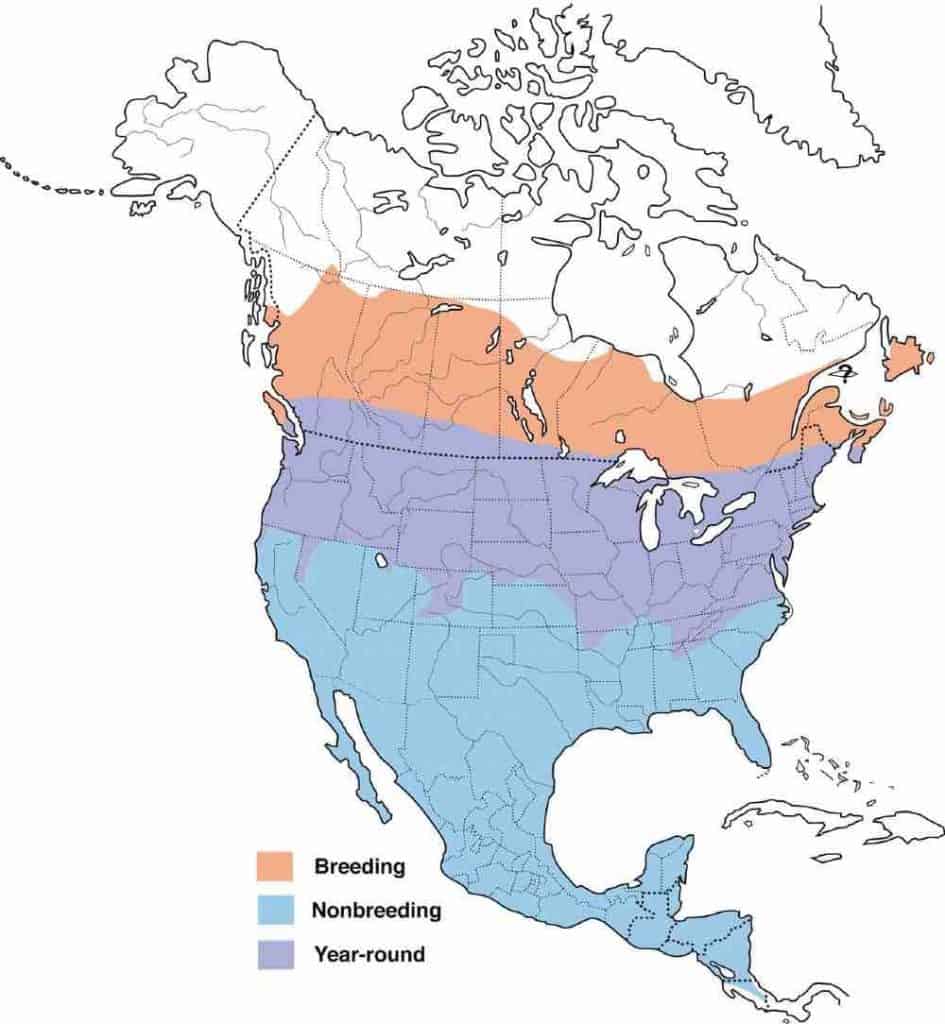
Cedar waxwings can be found all across North America. Since cedar waxwings are migrators, their specific location depends on the time of year.
- Some cedar waxwings live year-round in the northern part of the US and the southern part of Canada all the way from the west to the east coast.
- Some cedar waxwings migrate north to upper Canada to breed.
- Other cedar waxwings migrate to the southern US states and Mexico for winter and return north around the May-June timeframe.
What do Cedar Waxwings Look Like?
Hide your valuables the masked bandit – known as the cedar waxwing – is nearby! Probably the most identifiable attribute of this handsome bird is the black mask around its eyes followed by the yellow-tipped tail.
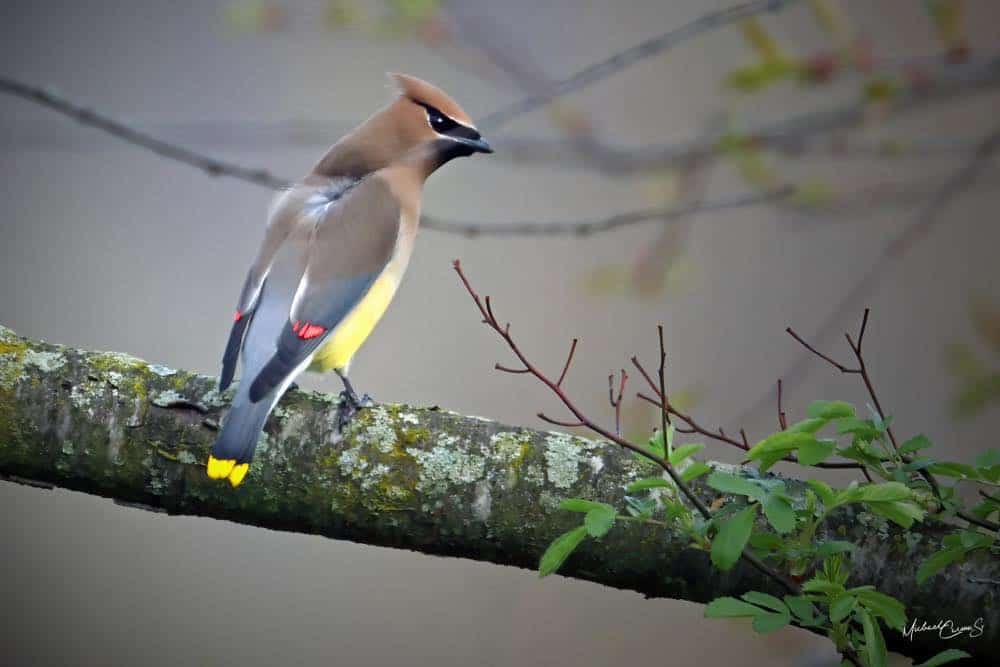
The cedar waxwing is about 7 1/4″ long, about the size of a bluebird.
It gets its name from a fruit-bearing tree it favors (cedar) and the red waxy substance produced at the tips of its secondary wings (waxwing). As of this writing, there is no known purpose for this waxy substance.
The cedar waxwing is a sleek-looking bird, primarily light brown with a silky crest of the same color, a yellow belly, a bright yellow tip on the tail, varying shades of brown underneath, and a touch of red at the tip of the upper wings. The beak is black, short, and pointy.
Male and female adults look pretty much the same with one very subtle difference – the black on the male’s chin encompasses a slightly larger area than the female’s. (Finally! A female bird as good-looking as the male!)
Juveniles look similar except the face and belly have more white, and the belly is striped.
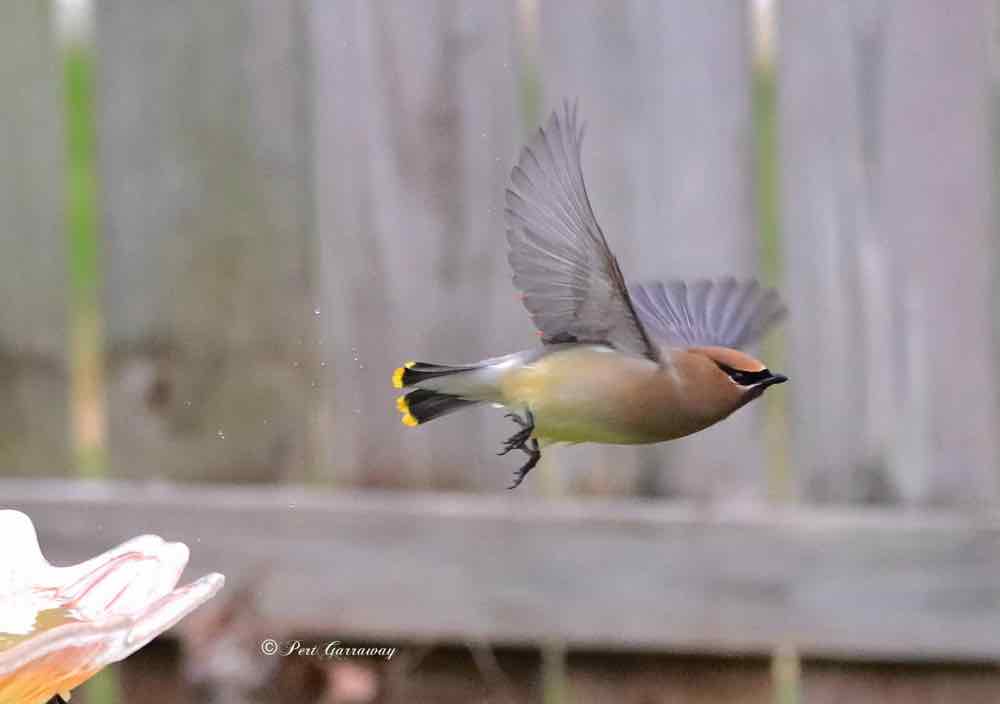
The cedar waxwing has a unique movie-star appearance and is unlikely to be confused with another bird.
Even its close relative, the Bohemian Waxwing, is distinctly gray vs. brown, so you won’t mistake one for the other.
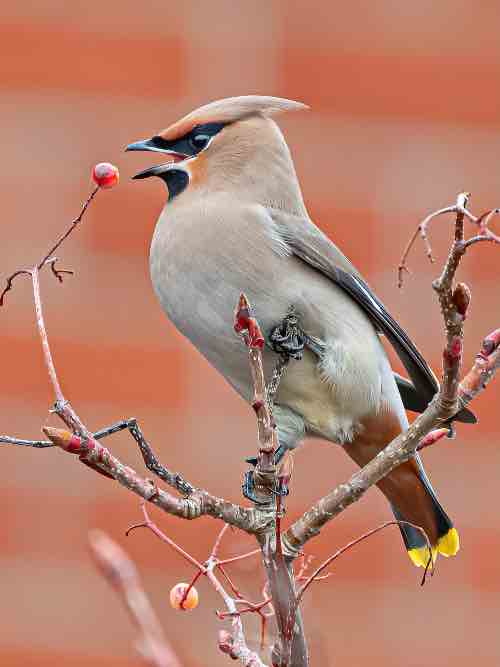
Where do Cedar Waxwings Live?
These birds are commonly found in open forested areas, orchards, and even wooded residential areas. They’re very social birds generally seen in flocks of dozens to over a hundred.
You’ll soon learn that cedar waxwings’ diet is almost exclusively fruit – so it only makes sense they make their homes in and around fruit-bearing trees and shrubs. Here are some of their favorite fruit-bearing trees & shrubs:
- Peppertree
- Cherry
- Grap
- Gooseberry
- Strawberry
- Mistletoe
- Apple
- Hawthorn
- Dogwood
- Red Cedar (namesake)
- Dogwood
- Hackberry
- Chokeberry
- Mulberry
- Serviceberry
- Viburnum
- Pokeweed
- Mountain Ash
- Elderberry
Once they’ve picked an area clean of berries, cherries, and apples they’ll move on to the next tasty spot. For this reason, if you happen to have them visit your feeder they are unlikely to stay long.
Cedar waxwings are also fond of riverbank passageways so you will commonly spot them there.
What do Cedar Waxwings Eat?
Cedar waxwings are frugivores. Meaning, they thrive mostly on fruits. Fruit is part of their lifestyle – even involved in their mating ritual (more on that later).
When the search for berry-producing trees and shrubs is not fruitful (pun intended) they’ll turn to insects to supplement their diet.
Why do Cedar Waxwings get drunk?
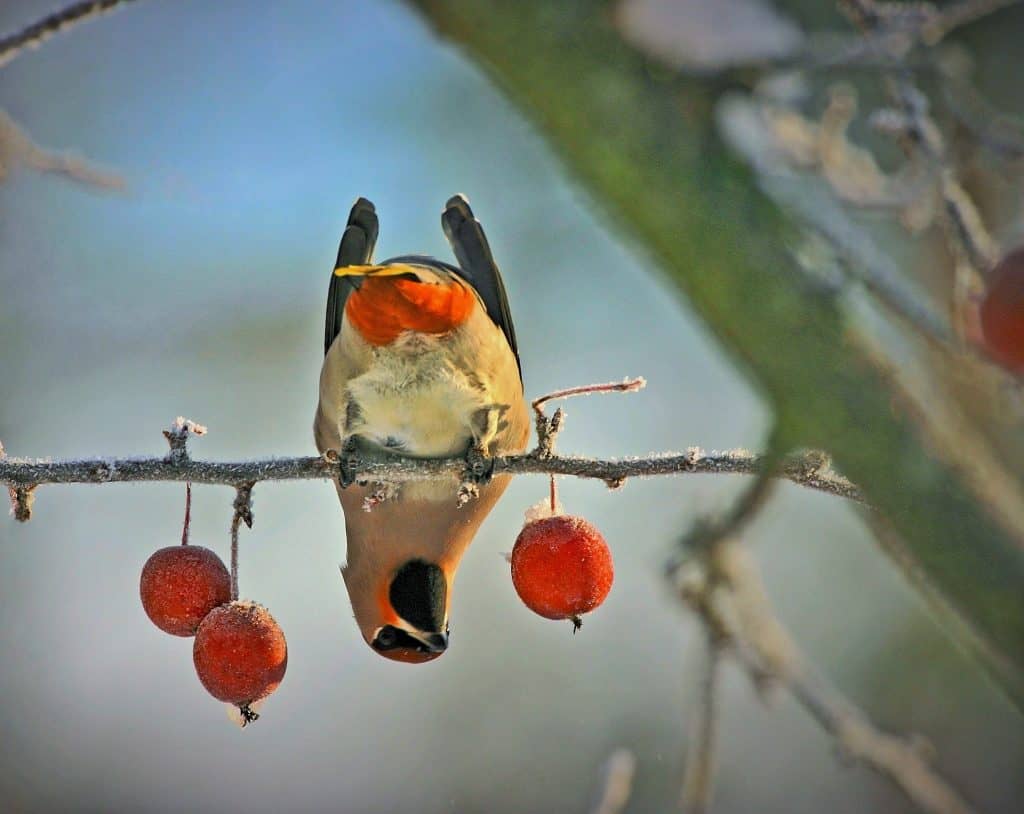
You might ask how a bird that eats so much fruit, some fermented, avoids getting drunk. The answer is, sometimes they don’t! There have been sightings of tipsy cedar waxwings staggering around or lying under a berry bush to “sleep it off”.
What do Cedar Waxwings Sound Like?
Cedar waxwings are considered “songbirds” However because they’re not territorial, they don’t have a song.
Their call is strangely soft and high-pitched at the same time. Take a listen:
Mating, Nesting, Eggs & Fledgling
Cedar waxwings start breeding between June and August – after most songbirds have already hatched chicks. In fact, some of them begin mating as late as July-August in some parts of the country. Fruit ripening happens mid to late summer, the same time cedar waxwings are mating. A coincidence? I think not.
“Side hop” anyone? Cedar waxwings’ courtship starts when the male brings a gift of berry to the female and “passes” it to her. She then hops to the side, away from him, then hops back and passes the gift of food back to the male. This is repeated a number of times (exact number unknown) until the female decides to eat the gift!
It’s a real treat to behold if you’re lucky enough. Lucky for you I found this amazing video showing it in real-time.
When they’re expecting, the pair will construct their open-cup style nest 6-20′ high in a tree. It’s comprised of twigs, weed stems, and other plant material.
The female lays between 3-5 eggs at a time and incubation is performed by the female for 12-14 days. The eggs are blue-gray and often spotted with black or gray.
Both parents feed the babies.
Parents need to keep watch for blue jays and house wrens which have been known to kill their eggs and fledglings.
Cedar waxwing fledglings are ready to leave the nest around 14-18 days after hatching.
Predators
According to The National Wildlife Federation, cedar waxwings can fall prey to merlins, hawks, and common grackles are predators of adult cedar waxwings. And, they can sometimes fall victim to bullfrogs when they drink from ponds.
Three Secret Ways to Attract Cedar Waxwings to Your Yard
1. Plant fruit-bearing trees and shrubs

Attract cedar waxwings by planting fruit trees and shrubs in and around your yard. After all, fruit is just about the only thing waxwings eat!
Here are some relatively common fruit-bearing plants you can try planting:
- Strawberry
- Apple
- Hawthorn
- Dogwood
- Red Cedar (namesake)
- Dogwood
- Hackberry
- Chokeberry
- Mulberry
- Serviceberry
- Viburnum
- Elderberry
2. Have water available
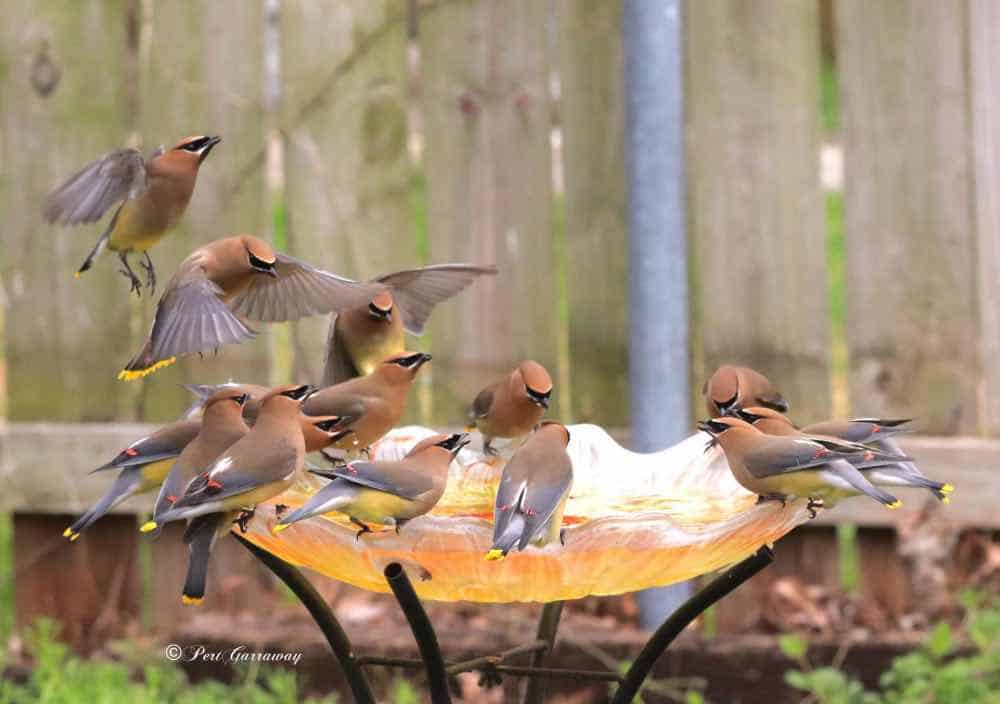
Attract cedar waxwings with water. All birds need water to drink and bathe in. Cedar waxwings are no different. If a natural source of water is not available nearby consider installing a pond – even a small patio pond will lure them in.
A birdbath is another viable option. Just make sure it’s big enough for his friends!
Birds are drawn to moving water so adding a fountain to the birdbath could increase your chances of enticing one as well.
3. Offer food they prefer in your feeder
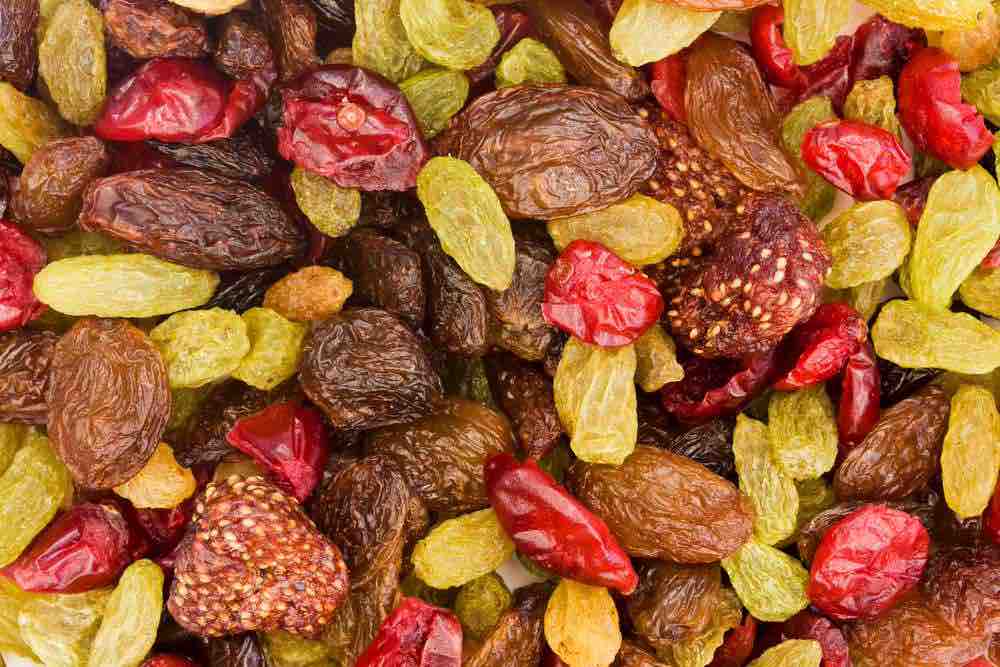
Do Cedar Waxwings visit the feeder?
Cedar Waxwings don’t ordinarily visit feeders. However, many backyard birders have had success inviting cedar waxwings to the feeder by offering dried fruit such as prunes, cranberries, raisins, apricots, and fruit & nut birdseed mix. Your best bet is to offer the food in an open feeder that enables them to perch comfortably while dining. Platform feeders are ideal for this purpose.
In late summer, when the fruit is becoming scarce, you can try putting out mealworms. Wiggly, live ones are sure to get their attention. Check out this video displaying an extreme example of enticing cedar waxwings to your feeder with mealworms!
Next Steps
I think you’ll agree handsome cedar waxwings are worth the effort to draw to your yard. Take and apply some of the tips I provided or if you’re really serious about attracting them to your yard – apply all of them! Good luck and happy birding!
Frequently Asked Questions
Are cedar waxwings rare?
The conservation status of cedar waxwing is low. Sightings of them are not rare. In fact, if you see one you see dozens and even hundreds as they are highly social and travel in flocks.
What is the scientific name for cedar waxwing?
The scientific name for the cedar waxwing is Bombycilla cedrorum.
What is the difference between a cedar waxwing and a Bohemian Waxwing?
The primary difference between cedar and bohemian waxwings is their coloring. Cedar waxwings are primarily light brown and yellow while Bohemian waxwings are primarily gray and peach. Cedar waxwings are also slightly smaller birds.



